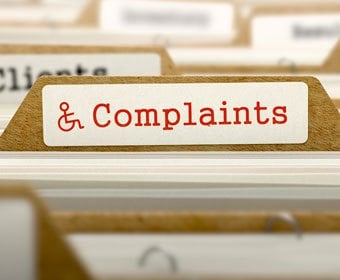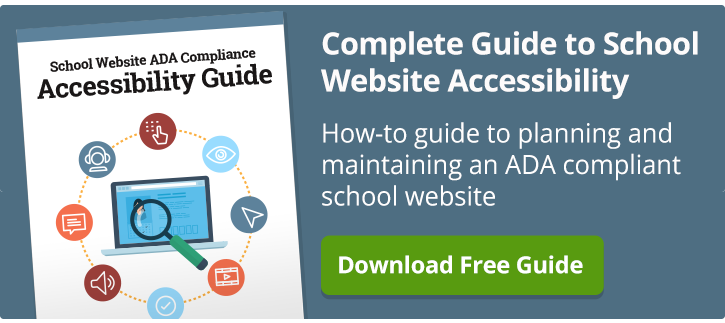As schools use technology to drive one-to-one initiatives and innovative teaching methods, ADA web accessibility is taking precedence. Take case learned through civil rights complaints against hundreds of schools like the one in Spokane Public Schools, where vision-impaired users found problems with the keyboard navigation and no alternate text to describe the content. Whole chunks of text were skipped over as they navigated the school’s web content.
As many as one in five of your students, parents, and community members require special technology tools and modifications to access the content or utilize features of a website or program. Although schools are well-intentioned institutions, complacency in technology can shut out users with disabilities.
The lesson here is that schools must account for all individuals and ensure that its technology, everything from websites to software applications, must comply with the American Disabilities Act and not discriminate against any user with disabilities.
As we often tell students, the advent of new technologies welcome a host of benefits, and greater responsibility. For schools, that responsibility is to all users, and even potential users. SchoolNow can help shoulder some of that responsibility through its comprehensive School Website Accessibility and ADA Education Center, including informative videos, blogs, and free downloadable guides.
Civil rights complaints hit hundreds of schools
These crackdowns, like the one in Spokane, MI, have swept across the nation hitting more than 500 school districts. What’s the end result? School administrators find themselves scrambling with their tech department overhauling their current practices to reach a resolution with the Office of Civil Rights. In some cases, schools have found themselves embroiled in a lawsuit. Schools then face great scrutiny leaving parents and community members distrusting of the education system. PR repair and regaining credibility is the last thing schools want to be doing when they are in the business of educating children.
Getting blindsided by a Civil Rights complaint is not only unsettling, but can drain resources and dampen morale. Taking measures before you are in the throes of a litigious dispute or OCR complaint, can mean a thorough and well-executed commitment to digital compliance and accessibility. This approach will also allow you to get buy-in from appropriating bodies like your school board, along with support from those who are charged with making the changes.
School technology cannot discriminate
Federally funded schools have done a great job of accommodating students with disabilities within the walls of their buildings; think wheelchair ramps, braille signage and classroom accommodations like small group instruction, but for many schools there lies an opportunity for growth when it comes to ADA accessibility in the digital space.
An implementation plan is a must
Schools can take proactive measures to ensure its innovative technology practices aren’t leaving users behind, especially since we know that 20 percent of the general population is living with a disability, according to the U.S. Census Bureau.
An implementation plan can start with a school website accessibility audit, schools can get a baseline of where they are with web accessibility and signal to stakeholders, advocacy groups, and government entities that you are focused on digital compliance.
While there are software applications and companies that specialize in audit reviews, a human review of your website can start by answering the following questions:
- Can you navigate your website just using the keyboard
- Does link highlighting work properly when navigating with keyboard?
- Do buttons and links have descriptive names?
- Is there enough contrast in your website colors for visually impaired people?
- Do you have descriptive alt tags for every image on your site?
- Do you have transcripts and closed-captioning for videos, including YouTube videos?
- Are all linked PDF files optimized for ADA?
- Are fields in your online forms properly labeled?
- Do you have a website accessibility policy available?
- Do you provide alternative ways for people to access information?
These and other checklist questions are contained in this free guide to school website accessibility. It also includes:
- How to evaluate your website for ADA compliance
- The top 12 accessibility issues plaguing school websites
- Common 'myths' about website accessibility
- How to make and keep your school website accessible
- What to do when a complaint is filed
Improving accessibility enhances user experience
As you propose new changes to your school’s website and other technologies to improve accessibility, it’s important to gain feedback from key stakeholders like parents, students, staff, and community representatives. This free website planning user survey guide will help you discover the kind of information that can translate into an optimal user experience on your school website.
Being transparent about the process to become digitally compliant, and welcoming feedback along the way will only further enhance the school to community partnership.
Once your school reaches 100% compliance in the digital realm, it’s critical to conduct bi-annual reviews to ensure your school maintains ADA accessibility for all users. Another prudent measure is to maintain a consistent communication stream with individuals with disabilities for regular feedback.
With ever-evolving technology, adaptation is a must for schools to ensure all-inclusive learning and accessibility. By being ADA compliant, you fulfill a fundamental idea of public education: reaching all learners.
Other related articles:
Topics: Website accessibility School Districts Private schools
About the author
Marketing director and content strategist for SchoolNow, Jay’s a former school public relations specialist who’s helped businesses, schools and colleges use the power of communications to improve their image, generate support, and optimize relationships. Reach him at jay@schoolnow.com.
.png?width=64&height=63&name=Group%20(4).png)
.png?width=66&height=64&name=Group%20(5).png)
.png?width=56&height=60&name=Group%20(6).png)
.png?width=66&height=52&name=Group%20(7).png)
.png?width=56&height=56&name=Group%20(9).png)
.png?width=59&height=52&name=Group%20(10).png)


